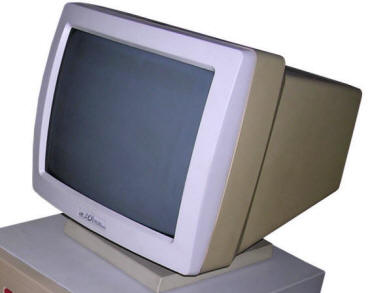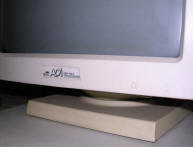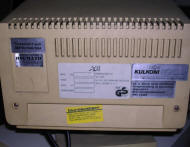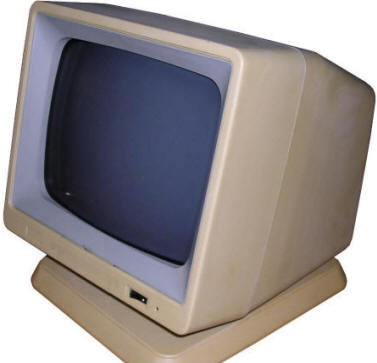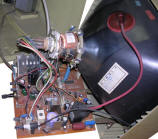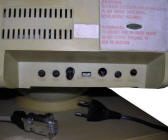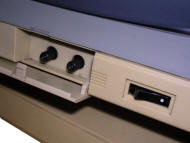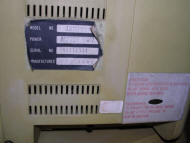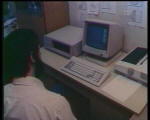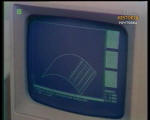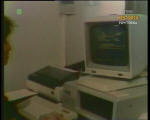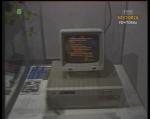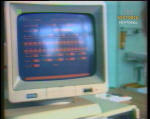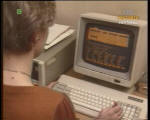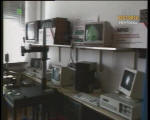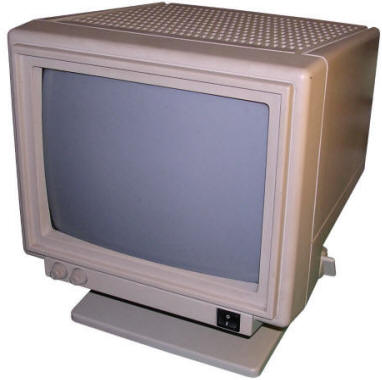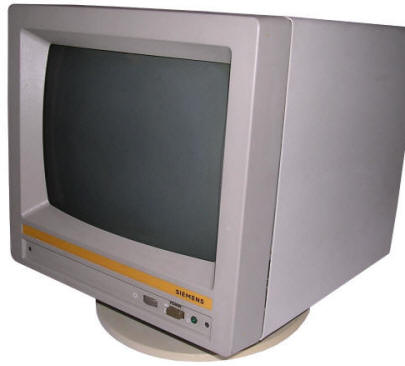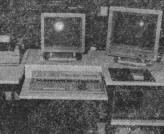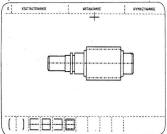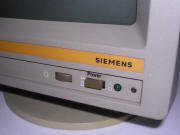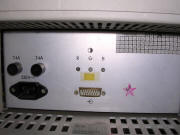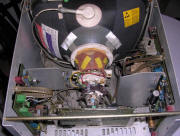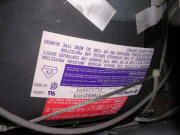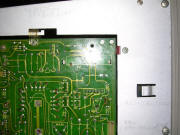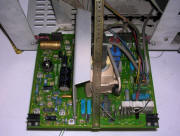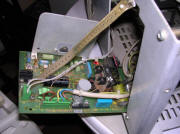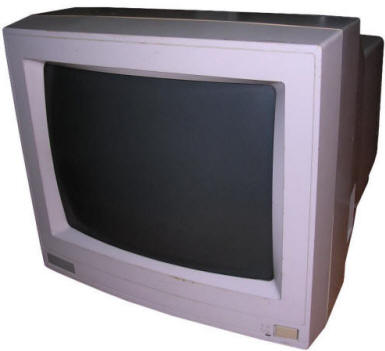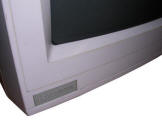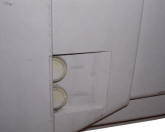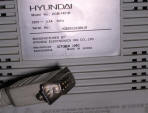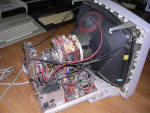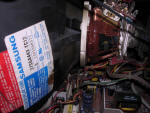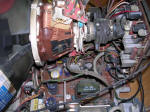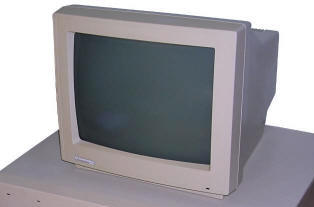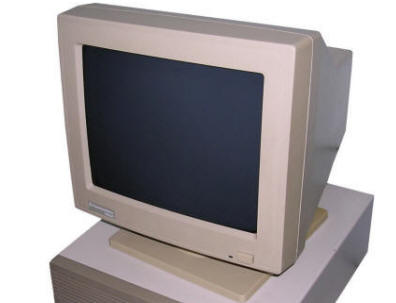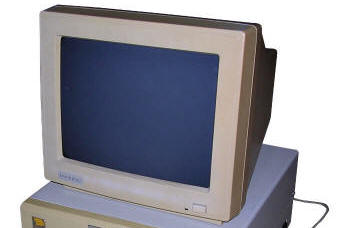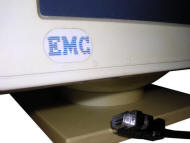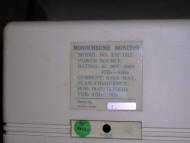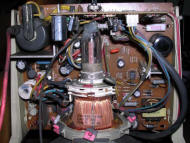Monitors and displays (1)
1980s PC and not-PC displays
In my collection, different PC displays accumulated over time with
computers, PCs, sometimes as part sources which have been surprisingly
repaired. From simple TV-like displays with green screens, to complex
monitors with digital control circuits. Here is a small travel around
these. Don't forget to look at some PCs, as they also have monitors to
complete a set.
PCs, in their initial form, were designed as office computers for editing text, using databases or calculating data. Such computer doesn't need a sophisticated display - monochrome screen showing letters encoded in a permanent font memory was totally sufficient. The first display card for PC called MDA - Monochrome Display Adapter, was showing text on a green-phosphor small CRT monitor connected by a cable (with separate signal and sync). PC clones used similar monochrome displays. With CGA (Colour Graphics Adapter) boards getting popularity, colour displays were still expensive. More, to display colours the circuit was far different than in colour TV - color information was sent as 4-bit TTL, marking R, G, and B colours as well as bigger or smaller "intensity". This made CGA displays work only with 16 colours. Popularization of higher-resolution raster-based graphics (like Hercules boards) made monochrome monitor manufacturers improve their products. Green CRTs became amber (what was a bit better readable in low-contrast conditions) and later white, imitating inverse-paper display. Hercules made an important step in mid-1980s, it was popular and offered a monochrome, high-resolution (720x350) graphics forcing monitor manufacturers to go up with quality. So the Big Blue shipped displays only for their computer sets, and other manufacturers made their own. Sometimes, when extended capabilities were needed, brecahing the standard. Of course there were displays made especially for some specific PC clones, which had capabilities outstanding MDA or CGA, or just had to be compatible only with these devices. A typical example can be monitor for Siemens PC-D or Robotron EC1834.
| ADI DM-14+ | ||
| Approx. year: | 1980s | |
| Type, connector: | DB9, MDA/Hercules | |
| CRT: | 12", mono, amber screen | |
| A
generic Monochrome/Hercules monitor with small amber CRT.
Underneath, it has a power switch and two sliders for brightness
and contrast. Its power connector is a power supply unit plug
for plugging into PC's power supply power output. According to Commodore Monitors list, the similar monitor (but no power LED in front) was sold ca. 1987 as Commodore DM-14, to PC20/40 PC-compatibles series. My unit comes from office, where it was used to edit text. It has even menu bar of TAG editor burned in its screen. According to stickers it was bought through German company and then imported to Poland. In 1980s it was a frequent method to buy electronics from the western Europe. |
||
|
|
||
| Intra IDM 12HP51T | ||
| Approx. year: | 1985 | |
| Type, connector: | DB9, MDA/Hercules | |
| CRT: | 12", mono, green screen | |
|
This is a really old monitor, made around 1985 in Taiwan by
Intra electronics. Its 12-inch green CRT allows to view MDA
image. It has a 9-pin connector and brightness/contrast controls
in front. It is really simple in construction - it has even
transformer-based power supply unit! These displays were common
in cheaper and more accessible PC clones from Taiwan. My unit has been used in a diagnostic instrument. It was operating since manufacturing without interruption, it got retired around 2007. 22 years of usage made its screen very dark and slow-reacting. |
||
|
Warning: There is a later (1987) monitor with the same designation, this is NOT this one. This later one has been also marketed asd INVES and has a nice orange power switch. It was also popular in Taiwanese PC clones. Let's
see some images from television in 1980s: | ||
| Olivetti | ||
| Approx. year: | 1986 | |
| Type, connector: | DB9, MDA/Hercules | |
| CRT: | 12", mono, green screen | |
| A monochrome unit with
built-in power supply, for computer or printer. Probably for
Olivetti
M19 computer. Looks typical for office computer these times. WARNING: Load the power supply before using. Just connect some old hard disk of car light bulb. Pinout, looking into connector ( | means flat side of pin): 1 2 X| 1 - -12V, |
||
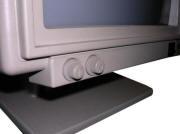
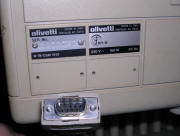
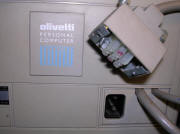
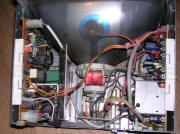 |
||
| Polkolor MM-14SP | ||
| Approx. year: | 1990 | |
| Type, connector: | DB9, TTL | |
| CRT: | 12" mono (amber) | |
| See Elwro 801AT for photos. A Polish monitor made by Elwro in small quantities using western semiconductors and tube, Polish passive components (but only some), switches, trimmers and casing. Its production probably had something to do with Schneider cooperation around 1988-1989 which ended quickly. | ||
| What's interesting this device is extremely
tolerant to input signals - can display many picture types
without problems, I connected it into different MDA, CGA,
Hercules and EGA variants (by converter) and it always shown
something. Usually the first failure is the input filter
capacitor, big red one. |
||
| Commodore 1402 | ||
| Approx. year: | 1988 | |
| Type, connector: | DB9, MDA/Hercules | |
| CRT: | 12" mono (white) | |
| See Commodore PC10 gallery for photos. This is of courde Hyundai, it was used with Commodore PC series. Commodore haven't used their original monitors for PC series, but purchased from usually Taiwanese companies. This approach was cheaper. | ||
| Commodore 1404 | ||
| Approx. year: | 1989 | |
| Type, connector: | DB9, MDA/Hercules | |
| CRT: | 12" mono (amber) | |
| See
its description. Definitely Hyundai display, used in early
PCs, as well as in some computers which emitted video in TTL
standard. It was also used in Commodore PC series. For the same unit, but branded Hyundai, see next item, Hyundai HMM-1401. My unit is in a good shape, but has periodic sync problems in Hercules modes. What is interestnig, it doesn't happen in MDA or text mode. I suspect capacitors. |
||
| Hyundai HMM-1401 | ||
| Approx. year: | 1990 | |
| Type, connector: | DB9, MDA/Hercules | |
| CRT: | 12" mono (amber) | |
| See California Access CA-286 PC for photos. This is very similar to Commodore 1404 and Commodore is an OEM. It was used with a California Access PC, but was available for many PC clones. Generally the trend was that if a computer is used in DOS, text mode and for simple text editing, the best solution is a monochrome monitor, even in early 1990s. | ||
|
|
Previous part |
|





